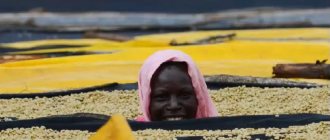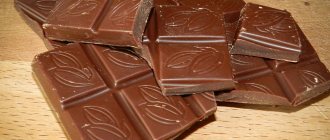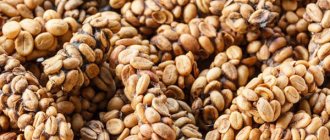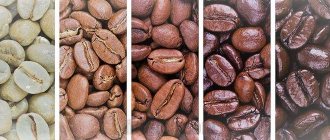The right coffee is the second half of success
The cezve has been chosen, but what next?
Of course, we choose the right coffee. In fact, any grain is suitable for cooking in a Turk. You can cook Arabica, Robusta, and mixtures in a cezve - it all depends solely on everyone’s personal preferences. Rich Brazilian coffee or fruity, sour Ethiopia are suitable for daily consumption. The degree of roasting and grinding of the beans are much more important for preparing delicious Turkish coffee. Contrary to the popular belief that oriental coffee is made from dark roasted beans, the richest natural flavor is produced by light and medium roasts. If you are on the “dark side” (and don’t like sourness), it is better to choose classic Viennese roasting, in which the acids from the grain are already gone, and the bitterness is still almost not felt.
An even more important factor for Turks is grinding. For cezve, it is customary to use ultra-fine ground coffee - into powder or dust. Firstly, this is a tradition that came to us from the East, namely from Turkey. Secondly, such grinding ensures the maximum area of contact between water and coffee particles and, accordingly, the best extraction (read more about extraction and degrees of coffee grinding in our article).
Let's start from the beginning - who should drink coffee?
Although a ton of research shows that coffee has health benefits, unfortunately, this doesn't apply to everyone. Whether coffee is right for you depends on genetics. Author of the book Ketotarian, Dr. Will Cole, explains: “We all have two variants of the caffeine gene, CYP1A2 and AHR, which determine how we metabolize caffeine. Either you metabolize caffeine quickly, meaning you tolerate it well and it is quickly eliminated from your body, or you metabolize caffeine slowly, meaning caffeine stays in your body longer, making its effects stronger and longer lasting.”
ONLINE COURSE ORGANIC WOMAN
Our authors and experts on nutrition, health and beauty: doctor Anna Medvedeva, nutritionist Veronika Khusnutdinova, nutritionist Nadya Andreeva and other “gurus” talk about nutrition and hormones in the Organic Woman course!
More about the course
According to Cole, those with both genes for fast metabolism can drink coffee without any discomfort and get all the benefits from it. “But if one of the genes is fast and the other is slow, or both are slow, then you are likely to experience not only the wake-up effect of caffeine, but also, unfortunately, shaky hands.”
You can find out your set of genes using a test, but you can also be guided by your feelings. If you don't feel very good (and even anxious) after drinking coffee, it's probably not good for you. If coffee makes you feel better, well, let's find the healthiest way to brew it.
Cooking correctly: all the secrets about Turkish coffee
The most correct recipe
Let's start with the fact that there is no absolutely correct recipe for making Turkish coffee, since everyone has different tastes: some people like sweet, thick coffee that looks like edible oil, some prefer coffee with spices, and some like bitterness. But there are recommended basic proportions that you can “play with” depending on your taste.
The classic recipe assumes a ratio of 1 to 10 (10 g of ground coffee per 100 ml of water or 20 g per 200 ml). If converted to teaspoons, then 1 spoon holds 4–7 grams of coffee, depending on the presence or absence of a “slide”.
Ground coffee must be poured into a vessel, poured with cold water (in Turkey, baristas often simplify the process and speed up the extraction by immediately pouring hot water) and put on the stove, selecting the lowest heat. You should only stir the coffee at the very beginning, but after a dense “cap” of coffee particles, carbon dioxide and aromatic oils has formed over the drink, there is no need to touch it. If a trickle of drink appears from under the cap, it means the coffee is ready and about to escape: you can remove it from the heat. It is recommended to pour coffee from a ceramic cezve right away, as the ceramic takes longer to cool down and the drink may begin to taste bitter. Metal or glass cezves can be left on the switched off stove for a few minutes so that the grounds settle to the bottom.
If you follow these simple rules, you can get aromatic, delicious coffee. But there is also an opportunity to improve it.
Commissioning (before first use)
There are a couple of tips that you should do before you start using a new Turk/Cezve:
- Rinse with clean water.
- Boil with lemon (except in the case of an aluminum pot).
- Brew the first portion with coffee, but do not drink it, but pour it out.
In total, this will give cleanliness, disinfection and slightly cover the inside of the Turk with essential oils, which will act as a kind of protective layer. After this, you can safely cook. Yes, washing the Turk with cleaning products, as well as in the dishwasher, is not recommended in principle.
Simple and proven life hacks for making the most delicious Turkish coffee
- Bring the coffee to foam only once. The idea, popular in Soviet times, that coffee should be heated three times for the best taste and strength has no basis in fact. This will result in overextraction: the drink will indeed become very strong, but at the same time too bitter, burnt and hollow.
- A few crystals of salt added at the very beginning of preparation can help bring out the flavor of the drink. First, sodium ions block taste buds that respond to bitter tastes, “switching” the perception to salty. Secondly, salt is, in principle, a flavor enhancer (perhaps the oldest and most popular in the world).
See how to properly add salt to coffee without spoiling its taste:
- Water is no less important than quality grains. Very briefly, ideal water should have the following characteristics: neutral pH, calcium hardness of about 68 mg/L, total alkalinity 40 mg/L, sodium content 10 mg/L and TDS 150 mg/L. We wrote in more detail about how to choose water for coffee in our article.
- Preheating the cup will enhance the aroma of the coffee. In coffee shops, cups are heated by coffee machines, but at home it is enough to rinse the dishes with boiling water and then pour the drink from the cezve.
- Spices and sweeteners can save even the most uninteresting and boring coffee; just add them during cooking. Arabica + Robusta blends and pure Robusta require a little more spice than pure Arabica, as Robusta has not very pleasant earthy notes. Expensive Arabica varieties are best left without any additives in order to achieve maximum natural flavor.
- Ideally, you should grind coffee immediately before brewing: this way, most of the aromatic substances are preserved. Beans for 1-2 servings can be ground immediately with spices (but the coffee grinder must be thoroughly washed after this).
Coffee brewed in different ways also contains different amounts of caffeine.
Coffee brewed in a drip coffee maker contains the highest amount of caffeine - the longer the coffee brewing process, the more caffeine is released. Brewing in a French press also produces a relatively high-caffeine drink, but cold brew coffee tends to have less caffeine (although if you brew longer, the caffeine level will be higher).
“It’s worth noting that some coffee shops have stronger coffee than others. When in doubt, order an espresso or Americano - they contain 75 mg of caffeine per serving, while a cup of drip coffee has more than 100 mg of caffeine, adds nutritionist Jess Cording.
While caffeine itself is not uniquely good or bad, how it affects your body depends on your genetic makeup. Those with one or two slow genes should prefer drinks with lower caffeine content.
What, why and how to add to Turkish coffee
Cezve is considered the most experimental way of making coffee. Almost all other methods also allow you to add spices or sugar, but only after the drink is in the cup. In Turku, on the contrary, it is customary to add something at the very beginning. This, on the one hand, gives quite a lot of scope for creativity, and on the other hand, if the author of the drink overdoes it with additions, the coffee will be spoiled.
Sweeteners
Sugar is put into the Turk right away. To give it a more caramel taste, melt it over low heat, and then add coffee and water. Or they heat up a mixture of sugar and coffee, and then add water.
Despite numerous frightening but completely unscientific stories that heated honey is carcinogenic, adding it to coffee and even brewing them together in a Turkish coffee pot is, of course, possible. We have already written in more detail about the emergence of the myth about the dangers of heating honey in a separate article, but it is no sin to remind you: hydroxymethylfurfural (OMF), which Ayurveda adherents and some media scare Internet users with, is found in all products in which sugars are heat-treated in the presence of acids ( this is, for example, all preserves and jams). Another thing is that when heated, honey loses some of its beneficial qualities, but it is still added to coffee not for their sake, but for the sake of sweetness and taste.
What is the healthiest way to brew coffee?
To answer this question, it is worth considering two main factors - the potential toxicity of the container material and how the brewing method affects the coffee beans themselves.
Regarding the first factor, experts recommend a French press or pour over (a method of brewing coffee in which hot water is passed through ground coffee in a special funnel with a paper filter), since brewing occurs in a container made entirely of glass or stainless steel.
French press and pour over are also preferable from the point of view of the second factor: “The stainless steel mesh filter on the French press and the open pour over method help to release the essential oils of coffee, which not only improves its aroma, but also preserves polyphenols that have anti-cancer properties.” " explains Dave Asprey, who revolutionized the world of coffee with his invention of the bulletpfoof latte ("armor-piercing coffee" with added fat).
Other methods of brewing coffee have other disadvantages. "Your favorite capsule and single-serve coffee machines are less preferred due to the packaging of the capsules and the danger of mold growing in the machine itself if you don't clean it regularly and thoroughly," says Cole.
Diterpenes contained in oils help raise both LDL cholesterol and cholesterol in general, but studies have also shown that diterpenes are associated with many of the beneficial properties of coffee, including its ability to fight cancer.
Both capsule and standard drip coffee makers contain filters
,
which reduce the level of diterpenes in the resulting drink
. Instant coffee contains almost no diterpenes as they are filtered out during the processing process.
What about the trendy cold brew coffee? “This brewing method retains more diterpenes because it eliminates the need for paper filters,” says Vincent Pedre, RD, gut health expert and author of Happy Gut. “Coffee prepared this way also has lower acidity, making it easier on the stomach.”
Arabic coffee
Photo pixabay.com
If you somehow find yourself in some Arab country, keep in mind that the coffee traditions there are very unique. For example, first the drink is served to the oldest person present, it is indecent to ask for more, and if you are served coffee in a large mug, then it seems that you are not very welcome (this is done so that the unpleasant guest drinks everything at once and leaves quickly).
The grind for Arabic coffee is coarser than for Turkish coffee, and the presence of spices is a must.
Ingredients:
- 80 ml water;
- 2 tsp. medium grind coffee;
- 1/2 tsp. cardamom;
- sugar as desired.
Pour sugar into the cezve and lightly fry it until it turns light brown. Pour in cold water and turn on the heat again. As soon as the water boils, add coffee and cardamom into it and wait until the coffee boils again.
We remove the foam in the same way as in the previous recipe, the number of repetitions is three.
How to brew strong coffee?
All invigorating treats differ in one way or another in their strength. How to calculate the required measure? You need to know how many spoons of grains to use for a certain volume of water. All drinks can be divided into three categories:
- Weak – the coffee content is very small,
- Medium - those that are usually sold in all restaurants,
- Strong drinks are special drinks that help improve tone in the body.
Strong delicacies have their own names: the most famous throughout the world are espresso and ristretto.
The latter is distinguished by a very small volume of liquid (about 25 g) and a large volume of ground grains (about 7-13 g). Ristretto is very loved by the temperamental residents of Brazil and the Apennine Peninsula. It translates as “compressed, saturated.” For its preparation, only heavily roasted grains are used.
It is better to prepare this drink in a coffee machine, since it pours not only boiling water over the grains, but also steam. If you try to do something similar at home, the result will most likely be bad. Italians prefer to serve this delicacy with cold water to remove the taste sensations from previous dishes, and drink the drink after dinner. This prevents you from falling asleep and gives you the vigor necessary to digest food.
Water suitable for the recipe
Water is the basis of freshly brewed coffee. For home cooking, only clean water is suitable. You can use filtered water, but ideally the water should be spring water. If there are no other options, tap water will do.
But it is important to remember: the taste, aroma and benefits received from the drink directly depend on the purity and quality of the water.
The water must be cold: this will prolong the process of extraction of coffee beans, and, accordingly, will affect the depth and richness of taste and aroma.











